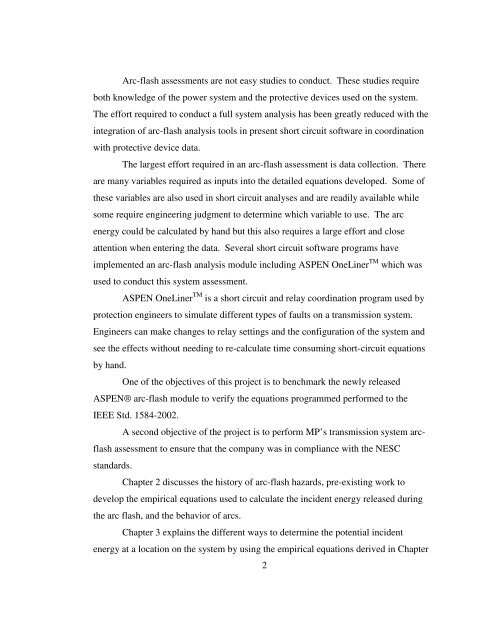arc-flash analysis of utility power systems - Michigan Technological ...
arc-flash analysis of utility power systems - Michigan Technological ...
arc-flash analysis of utility power systems - Michigan Technological ...
You also want an ePaper? Increase the reach of your titles
YUMPU automatically turns print PDFs into web optimized ePapers that Google loves.
Arc-<strong>flash</strong> assessments are not easy studies to conduct. These studies require<br />
both knowledge <strong>of</strong> the <strong>power</strong> system and the protective devices used on the system.<br />
The effort required to conduct a full system <strong>analysis</strong> has been greatly reduced with the<br />
integration <strong>of</strong> <strong>arc</strong>-<strong>flash</strong> <strong>analysis</strong> tools in present short circuit s<strong>of</strong>tware in coordination<br />
with protective device data.<br />
The largest effort required in an <strong>arc</strong>-<strong>flash</strong> assessment is data collection. There<br />
are many variables required as inputs into the detailed equations developed. Some <strong>of</strong><br />
these variables are also used in short circuit analyses and are readily available while<br />
some require engineering judgment to determine which variable to use. The <strong>arc</strong><br />
energy could be calculated by hand but this also requires a large effort and close<br />
attention when entering the data. Several short circuit s<strong>of</strong>tware programs have<br />
implemented an <strong>arc</strong>-<strong>flash</strong> <strong>analysis</strong> module including ASPEN OneLiner TM which was<br />
used to conduct this system assessment.<br />
ASPEN OneLiner TM is a short circuit and relay coordination program used by<br />
protection engineers to simulate different types <strong>of</strong> faults on a transmission system.<br />
Engineers can make changes to relay settings and the configuration <strong>of</strong> the system and<br />
see the effects without needing to re-calculate time consuming short-circuit equations<br />
by hand.<br />
One <strong>of</strong> the objectives <strong>of</strong> this project is to benchmark the newly released<br />
ASPEN® <strong>arc</strong>-<strong>flash</strong> module to verify the equations programmed performed to the<br />
IEEE Std. 1584-2002.<br />
A second objective <strong>of</strong> the project is to perform MP’s transmission system <strong>arc</strong><strong>flash</strong><br />
assessment to ensure that the company was in compliance with the NESC<br />
standards.<br />
Chapter 2 discusses the history <strong>of</strong> <strong>arc</strong>-<strong>flash</strong> hazards, pre-existing work to<br />
develop the empirical equations used to calculate the incident energy released during<br />
the <strong>arc</strong> <strong>flash</strong>, and the behavior <strong>of</strong> <strong>arc</strong>s.<br />
Chapter 3 explains the different ways to determine the potential incident<br />
energy at a location on the system by using the empirical equations derived in Chapter<br />
2
















